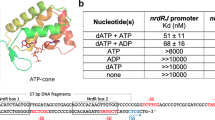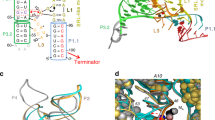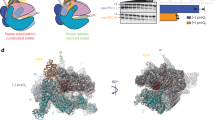Abstract
The ydaO riboswitch, involved in sporulation, osmotic stress responses and cell wall metabolism, targets the second messenger cyclic-di-AMP with subnanomolar affinity. We have solved the structure of c-di-AMP bound to the Thermoanaerobacter tengcongensis ydaO riboswitch, thereby identifying a five-helical scaffold containing a zippered-up bubble, a pseudoknot and long-range tertiary base pairs. Highlights include the identification of two c-di-AMP binding pockets on the same face of the riboswitch, related by pseudo-two-fold symmetry, with potential for cross-talk between sites mediated by adjacently positioned base-stacking alignments connecting pockets. The adenine rings of bound c-di-AMP molecules are wedged between bases and stabilized by stacking, base-sugar and sugar-sugar intermolecular hydrogen bonding interactions. The structural studies are complemented by isothermal titration calorimetry–based binding studies of mutants mediating key tertiary intermolecular contacts. The T. tengcongensis ydaO riboswitch, like its Bacillus subtilis counterpart, most likely functions through a transcription termination mechanism, with the c-di-AMP bound state representing an 'off' switch.
This is a preview of subscription content, access via your institution
Access options
Subscribe to this journal
Receive 12 print issues and online access
$259.00 per year
only $21.58 per issue
Buy this article
- Purchase on Springer Link
- Instant access to full article PDF
Prices may be subject to local taxes which are calculated during checkout





Similar content being viewed by others
References
Mironov, A.S. et al. Sensing small molecules by nascent RNA: a mechanism to control transcription in bacteria. Cell 111, 747–756 (2002).
Winkler, W., Nahvi, A. & Breaker, R.R. Thiamine derivatives bind messenger RNAs directly to regulate bacterial gene expression. Nature 419, 952–956 (2002).
Nudler, E. & Miranov, A.S. The riboswitch control of bacterial metabolism. Trends Biochem. Sci. 29, 11–17 (2004).
Winkler, W.C. & Breaker, R.R. Regulation of bacterial gene expression by riboswitches. Annu. Rev. Microbiol. 59, 487–517 (2005).
Serganov, A. & Nudler, E. A decade of riboswitches. Cell 152, 17–24 (2013).
Montange, R.K. & Batey, R.T. Riboswitches: emerging themes in RNA structure and function. Annu. Rev. Biophys 37, 117–133 (2008).
Serganov, A. & Patel, D.J. Ribozymes, riboswitches and beyond: regulation of gene expression without proteins. Nat. Rev. Genet. 8, 776–790 (2007).
Serganov, A. & Patel, D.J. Metabolic recognition principles and molecular mechanisms underlying riboswitch function. Annu. Rev. Biophys 41, 343–370 (2012).
Sudarsan, N. et al. Riboswitches in eubacteria sense the second messenger c-di-GMP. Science 321, 411–413 (2008).
Lee, E.R. et al. An allosteric self-splicing ribozyme triggered by a bacterial second messenger. Science 329, 845–848 (2010).
Tamayo, R., Pratt, J.T. & Camilli, A. Roles of cyclic diguanylate in the regulation of bacterial pathogenesis. Annu. Rev. Microbiol. 61, 131–148 (2007).
Cotter, P.A. & Stibitz, S. c-di-GMP–mediated regulation of virulence and biofilm formation. Curr. Opin. Microbiol. 10, 17–23 (2007).
Smith, K.D. et al. Structural basis of ligand binding by a c-di-GMP riboswitch. Nat. Struct. Mol. Biol. 16, 1218–1223 (2009).
Kulshina, N., Baird, N.J. & Ferre-D'Amare, A.R. Recognition of the bacterial second messenger cyclic diguanylate by its cognate riboswitch. Nat. Struct. Mol. Biol. 16, 1212–1217 (2009).
Smith, K.D. et al. Structural basis of differential ligand recognition by two classes of bis-(3′,5′)-cyclic dimeric guanosine monophosphate-binding riboswitches. Proc. Natl. Acad. Sci. USA 108, 7757–7762 (2011).
Smith, K.D. & Strobel, S.A. Interactions of the c-di-GMP riboswitch with its second messenger ligand. Biochem. Soc. Trans. 39, 647–651 (2011).
Barrick, J.E. et al. New RNA motifs suggest an expanded scope for riboswitches in bacterial genetic control. Proc. Natl. Acad. Sci. USA 101, 6421–6426 (2004).
Block, K.F., Hammond, M.C. & Breaker, R.R. Evidence for widespread gene control function by the ydaO riboswitch candidate. J. Bacteriol. 192, 3983–3989 (2010).
Watson, P.Y. & Fedor, M.J. The ydaO motif is an ATP-sensing riboswitch in Bacillus subtilis. Nat. Chem. Biol. 8, 963–965 (2012).
Nelson, J.W. et al. Riboswitches in eubacteria sense the second messenger c-di-AMP. Nat. Chem. Biol. 9, 834–839 (2013).
Witte, G., Hartung, S., Büttner, K. & Hopfner, K.P. Structural biochemistry of a bacterial checkpoint protein reveals diadenylate cyclase activity regulated by DNA recombination intermediates. Science 329, 845–848 (2010).
Corrigan, R.M. et al. Systematic identification of conserved bacterial c-di-AMP receptor proteins. Proc. Natl. Acad. Sci. USA 110, 9084–9089 (2013).
Corrigan, R.M. et al. c-di-AMP is a new second messenger in S. aureus with a role in controlling cell size and envelop stress. PLoS Pathog. 7, e1002217 (2011).
Fong, J.C. et al. Interplay between cyclic AMP-cyclic AMP receptor protein and cyclic di-GMP signaling in Vibrio cholera biofilm formation. J. Bacteriol. 190, 6646–6659 (2008).
Gao, P. et al. Cyclic [G(2′,5′)pA(3′,5′)p] is the metazoan second messenger produced by DNA-activated cyclic GMP-AMP synthase. Cell 153, 1094–1107 (2013).
Diner, E.J. et al. The innate immune DNA sensor cGAS produces a noncanonical cyclic dinucleotide that activates human STING. Cell Reports 3, 1355–1361 (2013).
Ablasser, A. et al. cGAS produces a 2′,5′-linked cyclic dinucleotide second messenger that activates STING. Nature 498, 380–384 (2013).
Zhang, X. et al. Cyclic GMP-AMP containing mixed phosphodiester linkage is an endogenous high-affinity ligand for STING. Mol. Cell 51, 226–235 (2013).
Serganov, A., Huang, L. & Patel, D.J. Coenzyme recognition and gene regulation by a FMN riboswitch. Nature 458, 233–237 (2009).
Huang, L., Ishibe-Murakami, S., Patel, D.J. & Serganov, A. Long-range pseudoknot interactions dictate the regulatory response in the tetrahydrofolate riboswitch. Proc. Natl. Acad. Sci. USA 108, 14801–14806 (2011).
Trausch, J.J., Ceres, P., Reyes, F.E. & Batey, R.T. The structure of a tetrahydrofolate-sensing riboswitch reveals two ligand-binding sites in a single aptamer. Structure 19, 1413–1423 (2011).
Pikovskaya, O. et al. Preparation and crystallization of riboswitch-ligand complexes. Methods Mol. Biol. 540, 115–128 (2009).
Pape, T. & Schneider, T.R. HKL2MAP: a graphical user interface for phasing with SHELX programs. J. Appl. Crystallogr. 37, 843–844 (2004).
Adams, P.D. et al. PHENIX: building new software for automated crystallographic structure determination. Acta Crystallogr. D Biol. Crystallogr. 58, 1948–1954 (2002).
Emsley, P. & Cowtan, K. Coot: model-building tools for molecular graphics. Acta Crystallogr. D Biol. Crystallogr. 60, 2126–2132 (2004).
Murshudov, G.N., Vagin, A.A. & Dodson, E.J. Refinement of macromolecular structures by the maximum-likelihood method. Acta Crystallogr. D Biol. Crystallogr. 53, 240–255 (1997).
Acknowledgements
We acknowledge assistance by staff at the X-29 beamline at the Brookhaven National Laboratory and NE-CAT beamlines at the Advanced Photon Source. We thank B. Gaffney and R. Jones of Rutgers University for samples of chemically synthesized cGAMP linkage isomers. The research was supported by US National Institutes of Health grant 1 U19 CA179564 to D.J.P.
Author information
Authors and Affiliations
Contributions
A.R. undertook all of the crystallographic and ITC experiments under the supervision of D.J.P.
Corresponding author
Ethics declarations
Competing interests
The authors declare no competing financial interests.
Supplementary information
Supplementary Text and Figures
Supplementary Results, Supplementary Tables 1–3 and Supplementary Figures 1–19. (PDF 38749 kb)
Rights and permissions
About this article
Cite this article
Ren, A., Patel, D. c-di-AMP binds the ydaO riboswitch in two pseudo-symmetry–related pockets. Nat Chem Biol 10, 780–786 (2014). https://doi.org/10.1038/nchembio.1606
Received:
Accepted:
Published:
Issue Date:
DOI: https://doi.org/10.1038/nchembio.1606
This article is cited by
-
A small RNA that cooperatively senses two stacked metabolites in one pocket for gene control
Nature Communications (2022)
-
The second messenger c-di-AMP mediates bacterial exopolysaccharide biosynthesis: a review
Molecular Biology Reports (2020)
-
RNA 3D structure prediction guided by independent folding of homologous sequences
BMC Bioinformatics (2019)
-
A c-di-AMP riboswitch controlling kdpFABC operon transcription regulates the potassium transporter system in Bacillus thuringiensis
Communications Biology (2019)
-
ykkC riboswitches employ an add-on helix to adjust specificity for polyanionic ligands
Nature Chemical Biology (2018)



